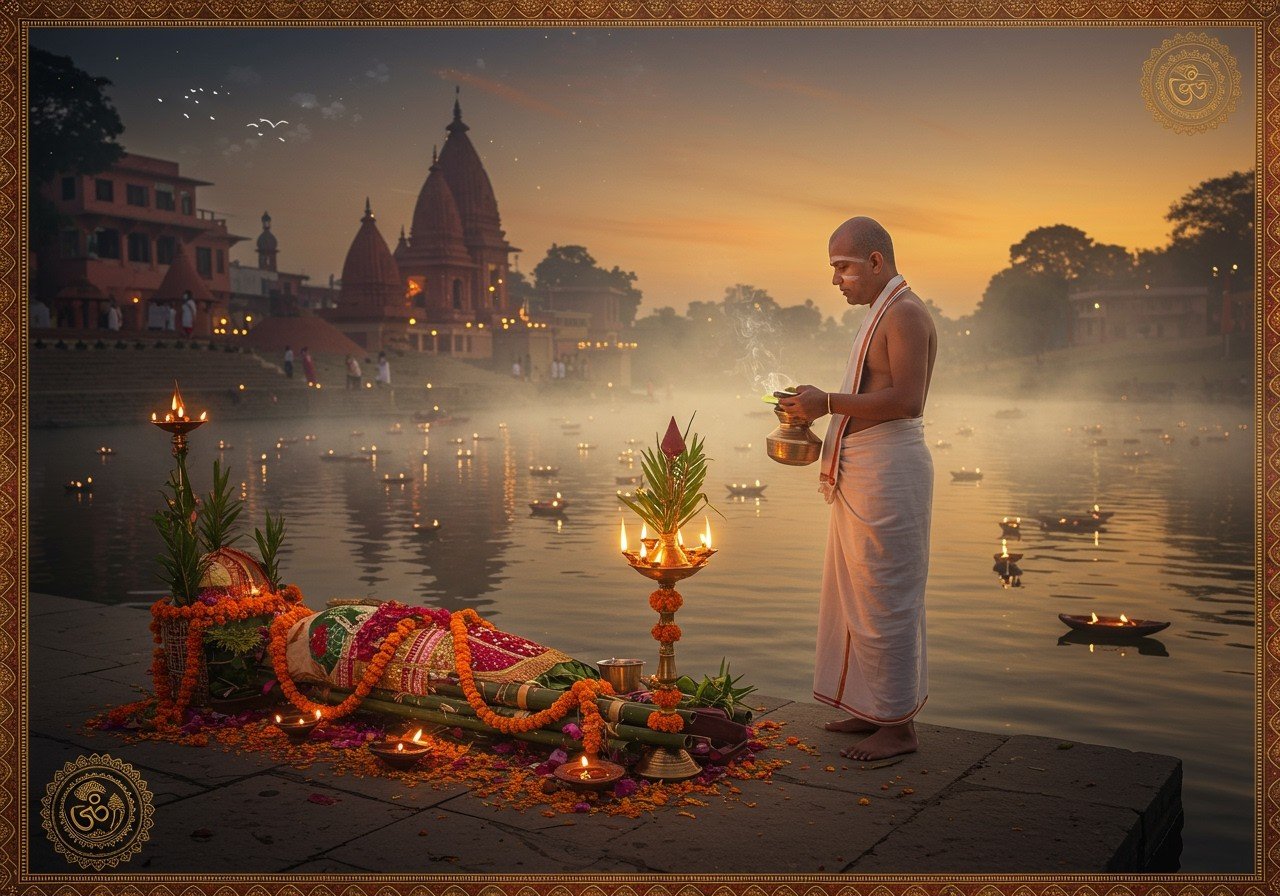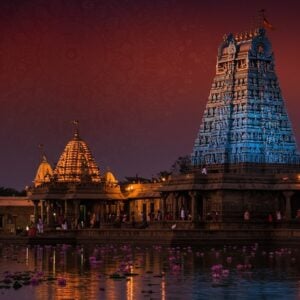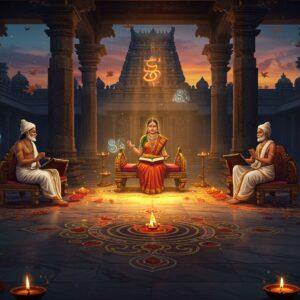
Death, though a natural part of life, is a time of deep sorrow and reflection. In Bengali Hindu culture, death rituals offer solace and guidance, helping families navigate grief while honoring the departed soul’s journey. These rituals, rich in symbolism and tradition, provide a framework for mourning, remembrance, and ultimately, acceptance. Let’s explore these sacred practices with reverence and understanding.
Pre-Cremation Rituals: Preparing for the Final Journey
The journey begins with pre-cremation rituals, focused on preparing the loved one for their transition. These initial steps are crucial, marking the beginning of the soul’s passage.
- The Vigil (Jagaran): Family and friends gather, maintaining a vigil by the bedside of the departing soul. Prayers, hymns, and readings from scriptures like the Bhagavad Gita available on Poojn.in fill the air, offering comfort and strength during the final moments.
- Preparing the Body (Shoshan): After the soul departs, the body is bathed with utmost care and reverence, symbolizing purification. It’s then dressed in traditional attire. Men and widows are usually draped in white, while married women are adorned in red. A tilak, a mark on the forehead, signifies blessings for the journey ahead. The big toes are gently tied together, symbolizing the finality of this earthly existence.
Cremation: The Sacred Fire
The cremation ceremony, a pivotal moment in the rituals, marks the physical release of the soul.
- Cremation Ground (Shmashan): The body is carried to the cremation ground, often near a riverbank, signifying the return to nature’s embrace. These locations are considered sacred, facilitating the soul’s transition to the next realm.
- The Pyre (Chita): A pyre is built with wood, arranged meticulously. The body is placed upon it, feet pointing northwards, aligning with the cosmic direction. The pyre represents the temporary nature of the physical body, preparing for its transformation through fire.
- The Lead Cremator (Dom): Traditionally, the eldest son leads the cremation ceremony, representing the continuation of lineage and responsibility. Other male relatives or a priest may also perform this role. Before lighting the pyre, the Dom bathes, purifying themselves for this sacred duty. Sacred threads, available on Poojn.in, are often worn during these rituals.
- Rituals at the Pyre: With deep respect, the lead cremator circles the pyre (Parikrama), offering prayers and hymns. Sesame seeds or rice are placed in the deceased’s mouth, symbolizing sustenance for the soul’s journey. Ghee (clarified butter) is sprinkled, purifying the body and pyre. The chanting of mantras further sanctifies the space and guides the soul’s transition.
- Lighting the Pyre (Mukhagni): Before lighting the pyre, a symbolic act takes place. An earthen pot filled with water is carried around the deceased, then broken near the head, symbolizing the separation of the soul from the body. The lead mourner ignites the pyre, commencing the soul’s liberation through fire. Close relatives often circle the burning pyre, offering their final respects and prayers.
- Post-Cremation Purification: Attendees purify themselves by bathing after the cremation, signifying the cleansing of both body and spirit. The ashes are carefully collected, later immersed in a holy river, marking the soul’s return to the elements and its union with the divine.
Mourning Period and Post-Cremation Rituals: Honoring the Departed
The mourning period, a time for remembrance and reflection, continues after the cremation. These post-cremation rituals are important for both the departed soul and the grieving family.
- Mourning Period (Aashoucha): The mourning period traditionally lasts for thirteen days. Family members observe certain restrictions, including abstaining from festivities and religious celebrations. This time is dedicated to honoring the memory of the departed, allowing space for grief and healing.
- Mourner’s Diet: During mourning, family members often adhere to a simple, sattvic diet. This typically consists of rice, dal, and vegetables, prepared without onion or garlic. This restrained diet reflects the solemnity of the occasion and signifies a focus on inner reflection.
- Shaving Head (Mundan): Sons and other male relatives may shave their heads and beards as a mark of respect and detachment. This act symbolizes shedding the old and embracing a new beginning, while honoring the cycle of life and death.
- Shraddha Ceremony: The Shraddha ceremony, performed on the 11th day, is a crucial ritual. It’s a way to honor the deceased and facilitate their entry into the realm of ancestors. A feast is prepared for relatives and Brahmin priests. Offerings of food, clothing, utensils, and sometimes even symbolic furniture are made for the departed soul. Poojn.in offers a wide range of Shraddha items to facilitate this important ceremony.
- Pinda Daan: A special food offering called “pinda” – cooked rice and often fish, especially in fish-loving Bengal – is offered. This signifies nourishment for the departed soul, ensuring their well-being in the afterlife.
- Sapindikarana (Union with Ancestors): A year after the death, the Sapindikarana ceremony is performed. This ritual integrates the deceased’s soul with their ancestors, symbolizing their final journey into the ancestral realm.
- Feeding the Crows (Kakboli): On the concluding day of mourning, crows are fed. This symbolic act is believed to help the departed soul cease wandering and find its way to Brahman, the ultimate reality. It represents the final farewell and release of the soul.
Modern Adaptations and Poojn.in: Supporting Traditions
While these rituals remain deeply rooted in tradition, modern life has brought some adaptations. For instance, deaths often occur in hospitals rather than at home. However, the core essence of the rituals remains unchanged. Poojn.in acknowledges this delicate balance between tradition and modern needs. We offer a wide range of authentic puja samagri, from bhojpatra to clay diyas, making it convenient for families to perform these sacred rites with utmost authenticity.
Poojn.in understands the profound significance of these rituals and aims to support families during these challenging times. We offer a comprehensive selection of ritual items, delivered with respect and care. Our online platform ensures easy access to everything needed for a dignified farewell, helping families honor their loved ones according to tradition.
Visit Poojn.in today to explore our collection and find everything you need to observe these meaningful rituals.
Frequently Asked Questions about Bengali Hindu Death Rituals
What are the core elements of Bengali Hindu death rituals? The core elements encompass preparing the body, the cremation ceremony, the mourning period, Shraddha, and other post-cremation rites, all aimed at guiding the soul to the afterlife.
How long is the traditional mourning period? The mourning period typically lasts 13 days, a time for reflection and remembrance, with certain restrictions observed by family members.
What is the significance of the Shraddha ceremony? Shraddha is a crucial ritual for honoring the deceased and facilitating their transition into the ancestral realm. It involves offerings of food and prayers.
What is the purpose of Tarpan? Tarpan, the offering of water mixed with sesame seeds, honors ancestors and expresses gratitude, seeking their blessings.
Who traditionally performs the last rites? The eldest son usually performs the last rites, symbolizing the continuation of lineage and responsibility, though other male relatives or a priest may also perform this role.
What is Pinda Daan, and why is it important? Pinda Daan, the offering of rice balls (often with fish in Bengal), symbolizes sustenance for the departed soul’s journey in the afterlife.
What role does Ganga water play in these rituals? Ganga water, considered sacred, is used for purification, cleansing the deceased’s body and aiding their spiritual journey.
How can Poojn.in assist with these rituals? Poojn.in offers a wide array of authentic ritual items, providing convenient access to everything needed for observing these sacred ceremonies.
Explore Poojn.in’s collection of death ritual items to ensure a respectful and dignified farewell for your loved ones.
Navigating the intricacies of these rituals can be challenging during a time of grief. Poojn.in is here to provide support and guidance, ensuring that families can honor their loved ones with utmost respect and according to tradition.


